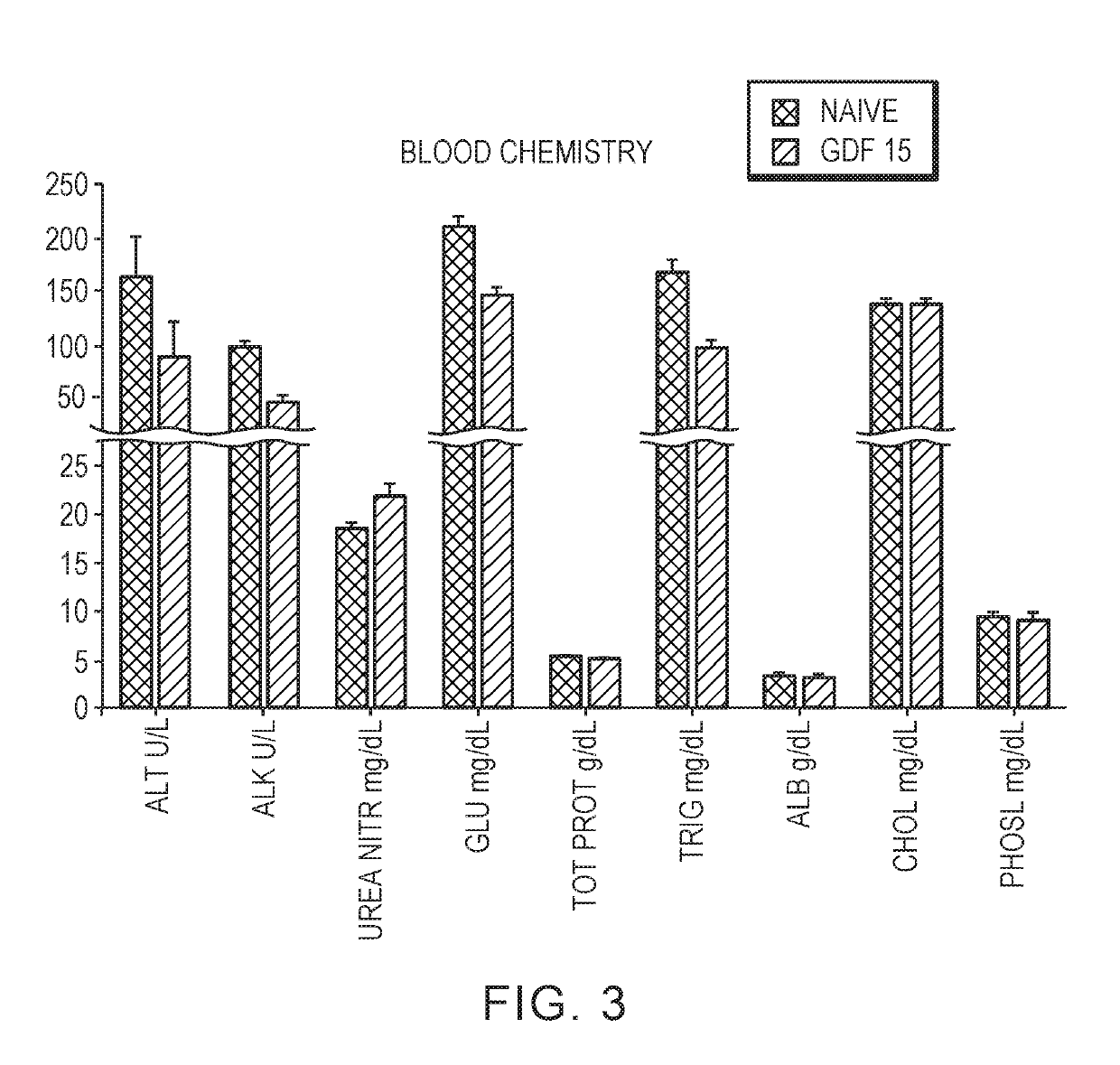Treatment of chronic kidney disease and other renal dysfunction using a gdf15 modulator
a technology of chronic kidney disease and modulator, which is applied in the field of gdf15 modulator, can solve the problems of ckd-affected patients being prone to suffer aki-like events, common and expensive kidney disease, and reducing kidney function or kidney size, so as to reduce erythropoietin production and reduce the effect of kidney function
- Summary
- Abstract
- Description
- Claims
- Application Information
AI Technical Summary
Benefits of technology
Problems solved by technology
Method used
Image
Examples
example 1
Administration of Recombinant mFc-GDF15 Increases Blood Urea Levels
[0140]ICR SCID (spontaneous mutant T&B cell deficient) mice were injected intraperitoneally with a PBS solution (control) or 40 μg of a murine, recombinant Fc-GDF15 protein. Body weight, and molecular markers for muscle degradation (Atrogin, MurF1), adipogenesis (Glut4, Leptin, C / EPBβ) and lipid accumulation (Stearoyl-CoA desaturase, Fatty acid synthase) were measured after injection.
[0141]FIG. 1 shows that mice injected with Fc-GDF15 exhibited significant body weight loss. Similarly, mice injected with Fc-GDF15 exhibited significant loss of gonadal mass (FIG. 2A) and gastroc mass (FIG. 2B). The treated mice also exhibited upregulation of markers for muscle degradation (Atrogin, MurF1) and downregulation of markers of adipogenesis (Glut4, leptin) and lipid accumulation (stearoyl-CoA desaturase; fatty acid synthase).
[0142]Mice treated with Fc-GDF15 also exhibited lower levels of liver enzymes (alanine aminotransferase...
example 2
Treatment of Renal Hypotrophy in an HT-1080 Xenograft Tumor Model
[0143]This Example demonstrates the treatment of renal hypotrophy (as indicated by kidney weight loss) by an anti-GDF15 antibody (01G06) in an HT-1080 fibrosarcoma xenograft model. HT-1080 cells were grown in culture at 37° C. in an atmosphere containing 5% CO2, using Eagle's Minimum Essential Medium (ATCC, Catalog No. 30-2003) containing 10% FBS. Cells were inoculated subcutaneously into the flank of 8-week old female ICR SCID mice with 5×106 cells per mouse in 50% matrigel. Body weight was measured daily. When body weight reached 80%, the mice were randomized into two groups of five mice each. Each group received one of the following treatments via intraperitoneal injection: murine IgG control, murine 01G06 dosed at 2 mg / kg on day 1 and day 7. In this experiment, a group of five mice were sacrificed at the time of dosing (baseline or 80% body weight loss, without treatment) and at the end of study (seven days post do...
example 3
Treatment with Anti-GDF15 Antibody Reverses Elevated Levels of Urea Seen in Mice Bearing HT-1080 Human Tumor Xenographs
[0146]ICR SCID (spontaneous mutant T&B cell deficient) mice bearing HT-1080 human tumor xenografts, as in Example 2, exhibit cachexia. Systemic administration of 10 mg / kg of an anti-GDF15 antibody (Hu01G06-127) but not human IgG reversed the body weight loss observed in mice bearing HT-1080 human tumor xenografts (FIG. 5A), as well gonadal weight loss (FIG. 5B). Administration of the anti-GDF15 antibody also reversed elevated levels of urea observed in mice bearing HT-1080 human tumor xenografts (FIG. 6).
PUM
| Property | Measurement | Unit |
|---|---|---|
| body weight | aaaaa | aaaaa |
| mass | aaaaa | aaaaa |
| body-surface area | aaaaa | aaaaa |
Abstract
Description
Claims
Application Information
 Login to View More
Login to View More - R&D
- Intellectual Property
- Life Sciences
- Materials
- Tech Scout
- Unparalleled Data Quality
- Higher Quality Content
- 60% Fewer Hallucinations
Browse by: Latest US Patents, China's latest patents, Technical Efficacy Thesaurus, Application Domain, Technology Topic, Popular Technical Reports.
© 2025 PatSnap. All rights reserved.Legal|Privacy policy|Modern Slavery Act Transparency Statement|Sitemap|About US| Contact US: help@patsnap.com



